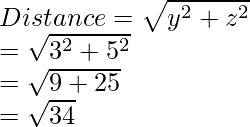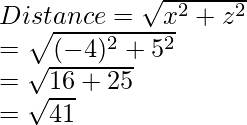Class 11 RD Sharma Solutions – Chapter 28 Introduction to 3D Coordinate Geometry – Exercise 28.1
Last Updated :
28 Dec, 2020
Question 1: Name the octants in which the following points lie:
(i) (5, 2, 3)
(ii) (-5, 4, 3)
(iii) (4, -3, 5)
(iv) (7, 4, -3)
(v) (-5, -4, 7)
(vi) (-5, -3, -2)
(vii) (2, -5, -7)
(viii) (-7, 2, -5)
Solution:
(i) (5, 2, 3)
Here, since x, y and z all three are positive then octant will be XOYZ
(ii) (-5, 4, 3)
Here, since x is negative and y and z are positive then the octant will be X′OYZ
(iii) (4, -3, 5)
In this case, since y is negative and x and z are positive then the octant will be XOY′Z
(iv) (7, 4, -3)
Here, since z is negative and x and y are positive then the octant will be XOYZ′
(v) (-5, -4, 7)
Here, since x and y are negative and z is positive then the octant will be X′OY′Z
(vi) (-5, -3, -2)
Here, since x, y and z all three are negative then octant will be X′OY′Z′
(vii) (2, -5, -7)
Here, since z and y are negative and x is positive then the octant will be XOY′Z′
(viii) (-7, 2, -5)
Here, since x and z are negative and x is positive then the octant will be X′OYZ′
Question 2: Find the image of:
(i) (-2, 3, 4) in the yz-plane
(ii) (-5, 4, -3) in the xz-plane
(iii) (5, 2, -7) in the xy-plane
(iv) (-5, 0, 3) in the xz-plane
(v) (-4, 0, 0) in the xy-plane
Solution:
(i) (-2, 3, 4)
We can change the x-coordinate in order to find the corresponding image in the yz plane.
Hence, Image of point (-2, 3, 4) is (2, 3, 4)
(ii) (-5, 4, -3)
We can change the y-coordinate in order to find the corresponding image in the xz plane.
Here, Image of point (-5, 4, -3) is (-5, -4, -3)
(iii) (5, 2, -7)
We can change the z-coordinate in order to find the corresponding image in the xy plane.
Here, Image of point (5, 2, -7) is (5, 2, 7)
(iv) (-5, 0, 3)
We can change the y-coordinate in order to find the corresponding image in the xz plane.
Here, Image of point (-5, 0, 3) is (-5, 0, 3)
(v) (-4, 0, 0)
We can change the z-coordinate in order to find the corresponding image in the xy plane.
Here, Image of point (-4, 0, 0) is (-4, 0, 0)
Question 3: A cube of side 5 has one vertex at the point (1, 0, 1), and the three edges from this vertex are, respectively, parallel to the negative x and y-axes and positive z-axis. Find the coordinates of the other vertices of the cube.
Solution:
Given:

A cube has side 4 having one vertex at (1, 0, 1)
Side of cube = 5
We have to find the coordinates of the other vertices of the cube.
So,
Let the Point A(1, 0, 1) and AB, AD and AE is parallel to –ve x-axis, -ve y-axis and +ve z-axis respectively.
Since side of cube = 5
Point B is (-4, 0, 1)
Point D is (1, -5, 1)
Point E is (1, 0, 6)
Now, EH is parallel to –ve y-axis
Point H is (1, -5, 6)
HG is parallel to –ve x-axis
Point G is (-4, -5, 6)
Now, again GC and GF is parallel to –ve z-axis and +ve y-axis respectively
Point C is (-4, -5, 1)
Point F is (-4, 0, 6)
Question 4: Planes are drawn parallel to the coordinates planes through the points (3, 0, -1) and (-2, 5, 4). Find the lengths of the edges of the parallelepiped so formed.
Solution:
Given:
Points are (3, 0, -1) and (-2, 5, 4)
We have to find the lengths of the edges of the parallelepiped formed.
For point (3, 0, -1)
x1 = 3, y1 = 0 and z1 = -1
For point (-2, 5, 4)
x2 = -2, y2 = 5 and z2 = 4
Plane parallel to coordinate planes of x1 and x2 is yz-plane
Plane parallel to coordinate planes of y1 and y2 is xz-plane
Plane parallel to coordinate planes of z1 and z2 is xy-plane
Distance between planes x1 = 3 and x2 = -2 is 3 – (-2) = 3 + 2 = 5
Distance between planes x1 = 0 and y2 = 5 is 5 – 0 = 5
Distance between planes z1 = -1 and z2 = 4 is 4 – (-1) = 4 + 1 = 5
Therefore,
The edges of parallelepiped is 5, 5, 5
Question 5: Planes are drawn through the points (5, 0, 2) and (3, -2, 5) parallel to the coordinate planes. Find the lengths of the edges of the rectangular parallelepiped so formed.
Solution:
Given:
Points are (5, 0, 2) and (3, -2, 5)
We have to find the lengths of the edges of the parallelepiped formed
For point (5, 0, 2)
x1 = 5, y1 = 0 and z1 = 2
For point (3, -2, 5)
x2 = 3, y2 = -2 and z2 = 5
Plane parallel to coordinate planes of x1 and x2 is yz-plane
Plane parallel to coordinate planes of y1 and y2 is xz-plane
Plane parallel to coordinate planes of z1 and z2 is xy-plane
Distance between planes x1 = 5 and x2 = 3 is 5 – 3 = 2
Distance between planes y1 = 0 and y2 = -2 is 0 – (-2) = 0 + 2 = 2
Distance between planes z1 = 2 and z2 = 5 is 5 – 2 = 3
Therefore,
The edges of parallelepiped is 2, 2, 3
Question 6: Find the distances of the point P (-4, 3, 5) from the coordinate axes.
Solution:
Given:
The point P (-4, 3, 5)
The distance of the point from x-axis is given as:

The distance of the point from y-axis is given as:

The distance of the point from z-axis is given as:

Question 7: The coordinates of a point are (3, -2, 5). Write down the coordinates of seven points such that the absolute values of their coordinates are the same as those of the coordinates of the given point.
Solution:
Given:
Point (3, -2, 5)
The Absolute value of any point(x, y, z) is shown by,
√(x2 + y2 + z2)
We need to make sure that absolute value to be the same for all points.
So let the point A(3, -2, 5)
Remaining 7 points are:
Point B(3, 2, 5) (By changing the sign of y coordinate)
Point C(-3, -2, 5) (By changing the sign of x coordinate)
Point D(3, -2, -5) (By changing the sign of z coordinate)
Point E(-3, 2, 5) (By changing the sign of x and y coordinate)
Point F(3, 2, -5) (By changing the sign of y and z coordinate)
Point G(-3, -2, -5) (By changing the sign of x and z coordinate)
Point H(-3, 2, -5) (By changing the sign of x, y and z coordinate)
Share your thoughts in the comments
Please Login to comment...